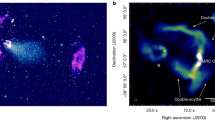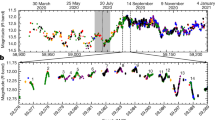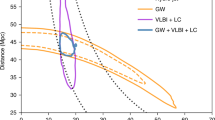Abstract
The variability of radio sources whose emission is dominated by single unresolved cores (core-dominated sources) is well estab-lished1. Evidence is also mounting that sources such as Cen A and 3C111, which are not core-dominated, also have varying cores2–4. Statistical studies of source fluxes using single-dish data and comparisons with known morphologies suggest that even in sources whose emission is swamped by that of the extended emission, the cores can be highly variable on timescales of weeks to years5,6. Here we present direct observational evidence for core variability of two lobe-dominated (weak-core) radio sources, GT1945 + 241 and GT0304 + 575. In the context of the beaming model, weak-core sources have little Doppler boosting and any residual variability is mainly intrinsic. The extreme nature of the core variability of the two sources described here suggests that the intrinsic variability can dominate beaming-related variability. If future studies reveal that this type of source is common, aspects of the beaming model, particularly in the context of the Unified Scheme, would be brought into question.
This is a preview of subscription content, access via your institution
Access options
Subscribe to this journal
Receive 51 print issues and online access
$199.00 per year
only $3.90 per issue
Buy this article
- Purchase on Springer Link
- Instant access to full article PDF
Prices may be subject to local taxes which are calculated during checkout
Similar content being viewed by others
References
Kellermann, K. I. & Pauliny-Toth, I. I. K. A. Rev. Astr. Astrophys. 19, 373–410 (1981).
Hine, R. G. & Scheuer, P. A. G. Mon. Not. R. astr. Soc. 193, 285–293 (1980).
Götz, M. M. A., Alef, W., Presuss, E. & Kellermann, K. I. Astr. Astrophys. 176, 171–174 (1987).
Kaufmann, P., Strauss, F. M., Coe, M. J. & Carpenter, G. F. Astr. Astrophys. 100, 189–190 (1981).
Duric, N., Gregory, P. C. & Taylor, A. R. Astr. J. 93, 890–897 (1987).
Hutchings, J. B., Price, R. & Gower, A. C. Astrophys. J. 329, 122–137 (1988).
Scheuer, P. A. G. & Readhead, A. C. S. Nature 277, 182–185 (1979).
Blandford, R. D. & Königl, A. Astrophys. J. 232, 34–48 (1979).
Orr, M. J. L. & Browne, I. W. A. Mon. Not. R. astr. Soc. 200, 1067–1080 (1982).
Rudnick, L., Jones, T. W. & Fiedler, R. Astr. J. 91, 1011–1018 (1986).
Gregory, P. C. & Taylor, A. R. Astr. J. 92, 371–411 (1986).
Duric, N. & Gregory, P. C. Astr. J. 95, 1149–1158 (1988).
Gregory, P. C. & Taylor, A. R. Astrophys. J. 248, 596–605 (1981).
Author information
Authors and Affiliations
Rights and permissions
About this article
Cite this article
Duric, N., Gregory, P. & Tsutsumi, T. Strong variability of weak-core radio sources. Nature 337, 143–145 (1989). https://doi.org/10.1038/337143a0
Received:
Accepted:
Issue Date:
DOI: https://doi.org/10.1038/337143a0
Comments
By submitting a comment you agree to abide by our Terms and Community Guidelines. If you find something abusive or that does not comply with our terms or guidelines please flag it as inappropriate.



